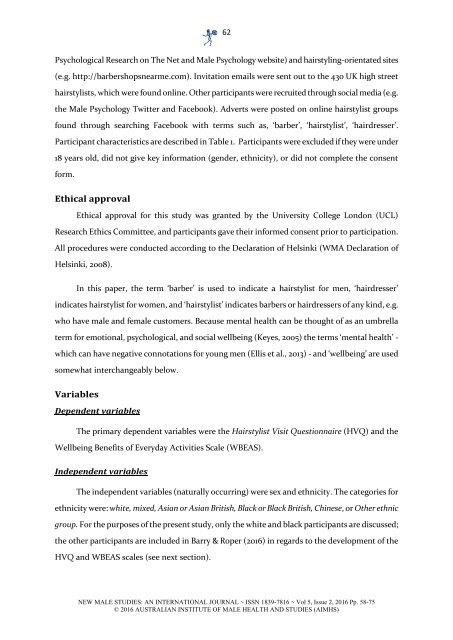IS HEALTH?
article-5
article-5
You also want an ePaper? Increase the reach of your titles
YUMPU automatically turns print PDFs into web optimized ePapers that Google loves.
62<br />
Psychological Research on The Net and Male Psychology website) and hairstyling-orientated sites<br />
(e.g. http://barbershopsnearme.com). Invitation emails were sent out to the 430 UK high street<br />
hairstylists, which were found online. Other participants were recruited through social media (e.g.<br />
the Male Psychology Twitter and Facebook). Adverts were posted on online hairstylist groups<br />
found through searching Facebook with terms such as, ‘barber’, ‘hairstylist’, ‘hairdresser’.<br />
Participant characteristics are described in Table 1. Participants were excluded if they were under<br />
18 years old, did not give key information (gender, ethnicity), or did not complete the consent<br />
form.<br />
Ethical approval<br />
Ethical approval for this study was granted by the University College London (UCL)<br />
Research Ethics Committee, and participants gave their informed consent prior to participation.<br />
All procedures were conducted according to the Declaration of Helsinki (WMA Declaration of<br />
Helsinki, 2008).<br />
In this paper, the term ‘barber’ is used to indicate a hairstylist for men, ‘hairdresser’<br />
indicates hairstylist for women, and ‘hairstylist’ indicates barbers or hairdressers of any kind, e.g.<br />
who have male and female customers. Because mental health can be thought of as an umbrella<br />
term for emotional, psychological, and social wellbeing (Keyes, 2005) the terms ‘mental health’ -<br />
which can have negative connotations for young men (Ellis et al., 2013) - and ‘wellbeing’ are used<br />
somewhat interchangeably below.<br />
Variables<br />
Dependent variables<br />
The primary dependent variables were the Hairstylist Visit Questionnaire (HVQ) and the<br />
Wellbeing Benefits of Everyday Activities Scale (WBEAS).<br />
Independent variables<br />
The independent variables (naturally occurring) were sex and ethnicity. The categories for<br />
ethnicity were: white, mixed, Asian or Asian British, Black or Black British, Chinese, or Other ethnic<br />
group. For the purposes of the present study, only the white and black participants are discussed;<br />
the other participants are included in Barry & Roper (2016) in regards to the development of the<br />
HVQ and WBEAS scales (see next section).<br />
NEW MALE STUDIES: AN INTERNATIONAL JOURNAL ~ <strong>IS</strong>SN 1839-7816 ~ Vol 5, Issue 2, 2016 Pp. 58-75<br />
© 2016 AUSTRALIAN INSTITUTE OF MALE <strong>HEALTH</strong> AND STUDIES (AIMHS)


